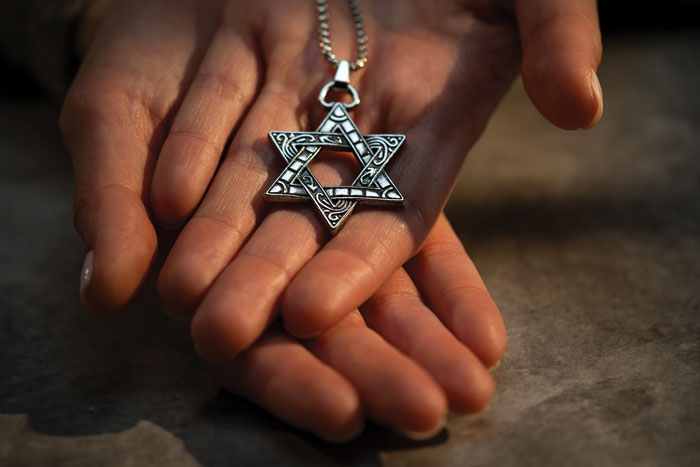Latkes, doughnuts and fritters — in Jewish homes, everyone’s frying this month, much as we have been for the last 2,000 years or so. Frankly, you’ve got to love a religion that actually encourages you to eat deep-fried foods — especially with sour cream!
All Jewish festivals have a culinary dimension, and Hanukkah (which this year begins at sundown Dec. 16) is no exception. In fact, it’s at the very heart of the event, although it’s the oil that is the important thing. In other words, the frying rather than the fried. Jewish traditions encompass both the sweet and savory, but the Ashkenazi latke is arguably in pole position in the Hanukkah festival food repertoire.
Let me be clear. I am talking dirty. I am not dealing here with “latkes-lite,” baked in the oven rather than fried in the pan. To my mind, the former has lost sight of its meaning and origin in the story of the Maccabees and the miracle of the menorah in the temple. It’s also lost a lot of its taste.
Back in the day, in the Jewish shtetls of Eastern Europe, the run-up to Hanukkah was also the time for fattening poultry — “Hanukkah is coming and the geese are getting fat” — as the old Hyman family saying went. Cooking oil was hard to obtain, and the main source of kosher solid fat for meat cookery came from chickens, ducks and geese. Schmaltz is still a delicious substitute in which to fry your latkes instead of oil, although the health police would say it’s like choosing between a heart attack and, er, a heart attack.
Potatoes, an essential latke ingredient
It should also be remembered that potatoes — that other essential component of the latke — didn’t arrive in Europe until the 16th century, and were not widely cultivated throughout Russia, Poland, Lithuania and the Ukraine until the early to mid-19th century. Once they became a staple, however, Hanukkah in the shtetls was never the same. Potatoes and goose fat were an obvious combination to create a pancake that was quickly fried — and just as quickly consumed. Indeed, the potato latke was probably directly responsible for generations of generous Jewish hips.
Quantity is all very well. Indeed, it is a hallowed Jewish tradition, but we’ve become a little more discriminating since potato first met oil. The designer latke is everywhere. Theoretically, and indeed gastronomically, there is nothing wrong in this. As the essence of the festival is in the oil and the frying, latkes can be made with any vegetable from beetroot to zucchini. However, for traditionalists, the potato will always be at the heart of things. Speaking personally, a latke without the potato is like fancy without the schmancy.
Making latkes is a serious business, responsible for blood, sweat and tears in probably equal proportions. In order to be prepared for the ordeal ahead, I offer this simple (hah!) guide. Study, take Prozac and GO FRY.

Getting ready to make latkes. Photos by Clarissa Hyman
Deconstructing the latke
Variety
You have to have the right potato. They should be floury not waxy.
Peeling or skin on?
This is where the trouble starts. Some leave the skin on, unless the potatoes are particularly coarse. Most insist peeled are best.
Soaking
There are two routes to go: whole-soak or shredded-soak.
With the first, you peel and soak the whole potatoes in cold water for between 30 minutes and 24 hours.
With the second, you grate the potatoes and soak in cold water for at least half an hour, rinsing in a few changes of clean, cold water. Some use lightly salted water for soaking.
Most authorities agree that if you are not going to soak, grating should be done only about 15 minutes before cooking or the potatoes will turn brown.
Grating vs. shredding
In other words, short, stubby bits vs. long, thin bits. Or fine grate vs. coarse grate.
If you go for a fine grate, you have to make sure it does not become a gluey pulp.
One technique is to coarsely shred the potato and onion (we’ll come to the latter, shortly) in a processor, then pulse briefly before adding the eggs (we’ll come to those later as well).
Hand grater vs. processor
In many homes, men were traditionally given the job of grating, while the women hovered over the frying pan — but gender role appropriation aside, the big question is, do you grate by hand or with a food processor.
Some swear that only grating by hand gives the right chunky texture; they also swear a lot when the blood from their knuckles flavors the latke mix.
If using a processor, the issue is the grating disc vs. pulsing. It depends whether you want a crunchy latke or one with a smoother consistency.
One writer uses the medium shredding blade and lays the potatoes horizontally in the feed tube to maximize the length of the strands.
Another of my acquaintances uses the processor to separately grate the potato and onion. She then combines half the potato in the processor with the onion, egg, bindings and seasoning and whirls to combine. She then mixes in the rest of the shredded potatoes.
Onion
To use or not to use, that is the question. This is a subject that can be cited as grounds for divorce.
Some onion users grate it together with the potato, others separately. Some say the onion juice helps the potatoes to stop turning brown.
Some do not grate the onion but cut it into small chunks.
Some finely chop the onion by hand.
Some alternately grate some of the onions on the large holes of the grater and some of the potatoes on the smallest holes.
Some of us start to cry.

Making latkes for Hanukkah.
Straining
We are now getting into advanced territory.
Once the potatoes and onion are ready, then everyone agrees they must be strained but should they be strained separately or together? Does it matter?
And what do you strain them in?
One writer places the potatoes in a colander, sprinkles them with salt, adds a layer of paper towels and tops with a heavy object.
Another lines a bowl with cheesecloth rather than using a colander. She holds this briefly under running water and squeezes it again thoroughly to remove excess moisture.
Many wring the grated potatoes and onions in a tea towel.
One poor soul cuts both the potatoes and onions into small dice, which she then grinds and drains. After adding eggs, seasoning and flour, she then drains again.
A subsection to this stage concerns the starch from the drained potato. You can collect the starch by straining the potato over a bowl, then pour off the liquid, leaving behind the potato starch/sediment. Do you use it or not?
Some swear by it. Others say it makes the latke go soggy. The Vilna Gaon does not pronounce on the issue.
Proportions
Good cooking, as everyone knows, is about balance, which is always difficult in high heels.
Everyone has their own secret formula although one pound of potatoes to one large onion to two large beaten eggs works pretty well. One daring soul has been known to add an extra egg yolk.
Binding
This does not mean tying yourself to the kitchen table. It is a serious issue. One must debate the different merits of matzo meal vs. flour or a half-and-half mixture of both. Plain vs. self-rising flour? And if so, how much?
One authority makes his batter firm enough to scoop up with his hands, so he can pat it into a pancake leaving a few straggly strands along the edge. For others, this is simply too solid a mix.
A minority caucus votes for potato flour: This has the merit of making the latkes more compact, firmer and easier to handle but, honestly, they are just not as lovely to eat.
Other ingredients
Salt and pepper seems straightforward but my mother always insisted on white pepper, and who am I to disagree?
Lemon juice, sugar and caraway seeds have also made an appearance in the kitchens of those who should know better.
Size
Now we’re really getting to the heavy stuff (perhaps that’s not the right word).
How large should a latke be? One or two tablespoon size? Do you flatten with the back of the spoon or a spatula?
Should they be thin or thick, what should be the surface to interior ratio, what about the crispy/creamy ratio?
Generally, the flatter they are, the crispier they will be — although if that’s how you like them, you probably live with someone who prefers thicker ones with a soft interior.

Fried latkes
Oil
It should be olive oil, although not necessarily your best extra virgin. Many people, however, use vegetable oil.
More complicated is the question of whether to deep or shallow fry. If the latter, how deep should the oil be in the pan? Half an inch? Or should the oil just “film” the bottom? Should you use a nonstick pan? Are you losing the will to live?
Temperature
This is crucial. If the temperature of the oil is not hot enough, the latkes go very greasy and stodgy. If the oil is too hot, then the outside burns before the inside is cooked.
Good hints: Preheat the empty pan before adding the oil; bring the raw mixture to room temperature before cooking; listen for the sizzle when the latkes hit the pan; don’t crowd the pan, or they become soggy.
Freezing
Freezing is possible, although purists insist they do lose a little je ne sais quoi. Frozen latkes should be fried from frozen or reheated in a hot oven on a wire rack to allow the hot air to circulate around the entire surface.
The X factor or the returnability factor
Ancient animosities aside, as all latkologists know, the test of a good latke is the returnability factor — are they so good you would return for more?
Conclusion
One batch is never enough. It takes several attempts to get it right — and apart from anything else, you have to keep testing the batch to see if it is up to standard.
But, at the end of the day, how can you ever judge a latke? It’s not just a question of shape, color, texture and taste but of emotional resonance, psychic energy, Jungian dreams and tribal loyalties. Not to mention hunger. Perhaps it’s simply a small miracle — which is why we’re frying now.
Zester Daily contributor Clarissa Hyman is an award-winning food and travel writer. She is twice winner of the prestigious Glenfiddich award among others. A former television producer, she now contributes to a wide range of publications and has written four books: “Cucina Siciliana,” “The Jewish Kitchen,” “The Spanish Kitchen” and “Oranges: A Global History.” She is based in Manchester, England, and is the vice president of the UK Guild of Food Writers.























 More news and opinions than at a Shabbat dinner, right in your inbox.
More news and opinions than at a Shabbat dinner, right in your inbox.